A Report on the Effectiveness of Marketing Communication and Promotion
VerifiedAdded on 2020/05/08
|11
|3268
|134
Report
AI Summary
This report assesses the effectiveness of marketing communication strategies, specifically focusing on advertising. It begins with an executive summary and an introduction to advertising, highlighting its role in influencing consumer behavior. The report then explores advertisement effectiveness, discussing how companies measure return on investment and factors like brand recall and persuasion. The report examines print media, outlining its advantages. The report then evaluates four print advertisements, comparing their effectiveness based on attention-grabbing capability, product benefits, visual attraction, and believability. It provides detailed analyses of each advertisement, including target markets and persuasion tactics. The report concludes with recommendations for improving advertisement effectiveness and influencing target audiences. The report also discusses different testing methods like pretesting, post-testing, and concurrent testing and their importance in the advertisement process.
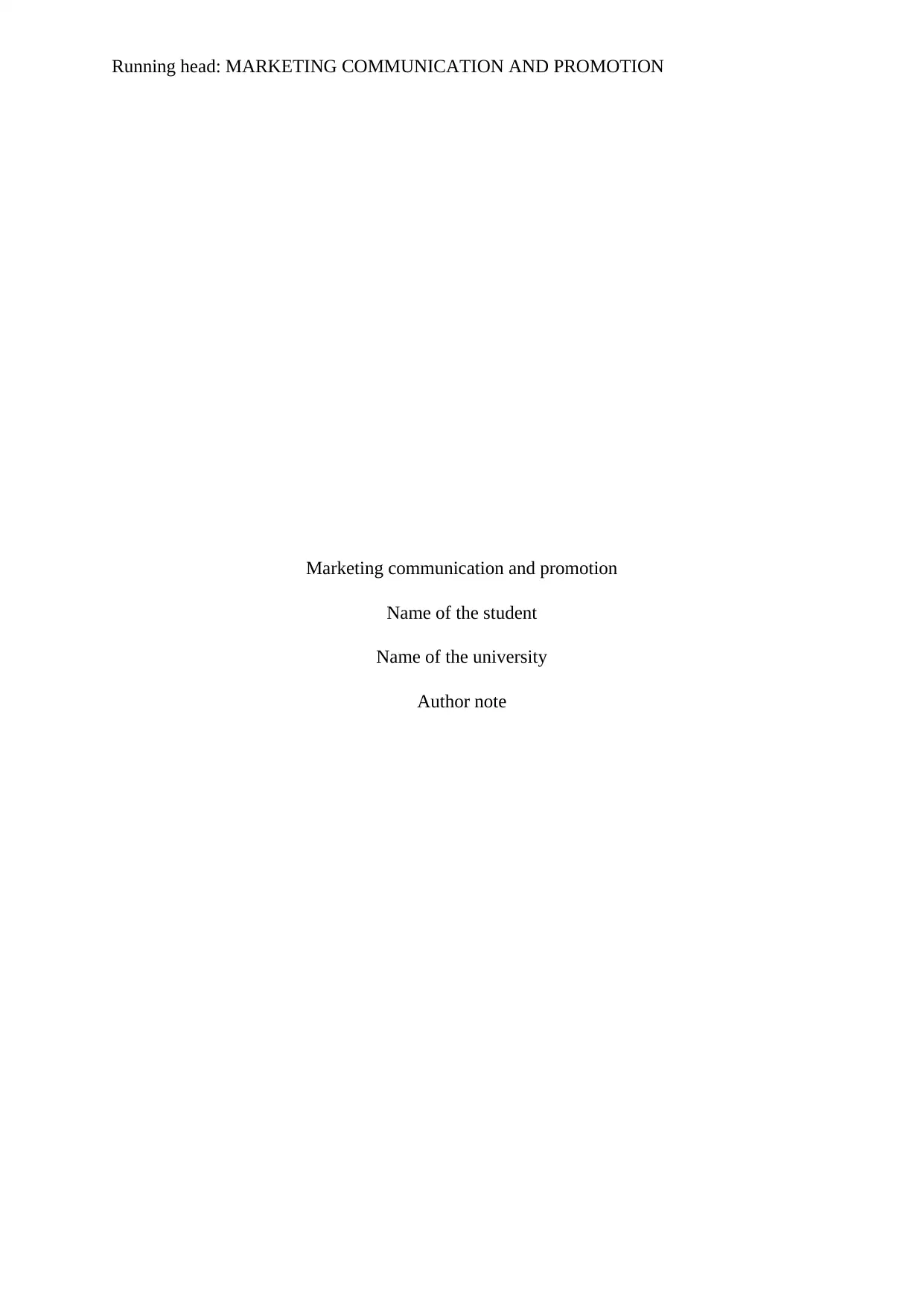
Running head: MARKETING COMMUNICATION AND PROMOTION
Marketing communication and promotion
Name of the student
Name of the university
Author note
Marketing communication and promotion
Name of the student
Name of the university
Author note
Paraphrase This Document
Need a fresh take? Get an instant paraphrase of this document with our AI Paraphraser
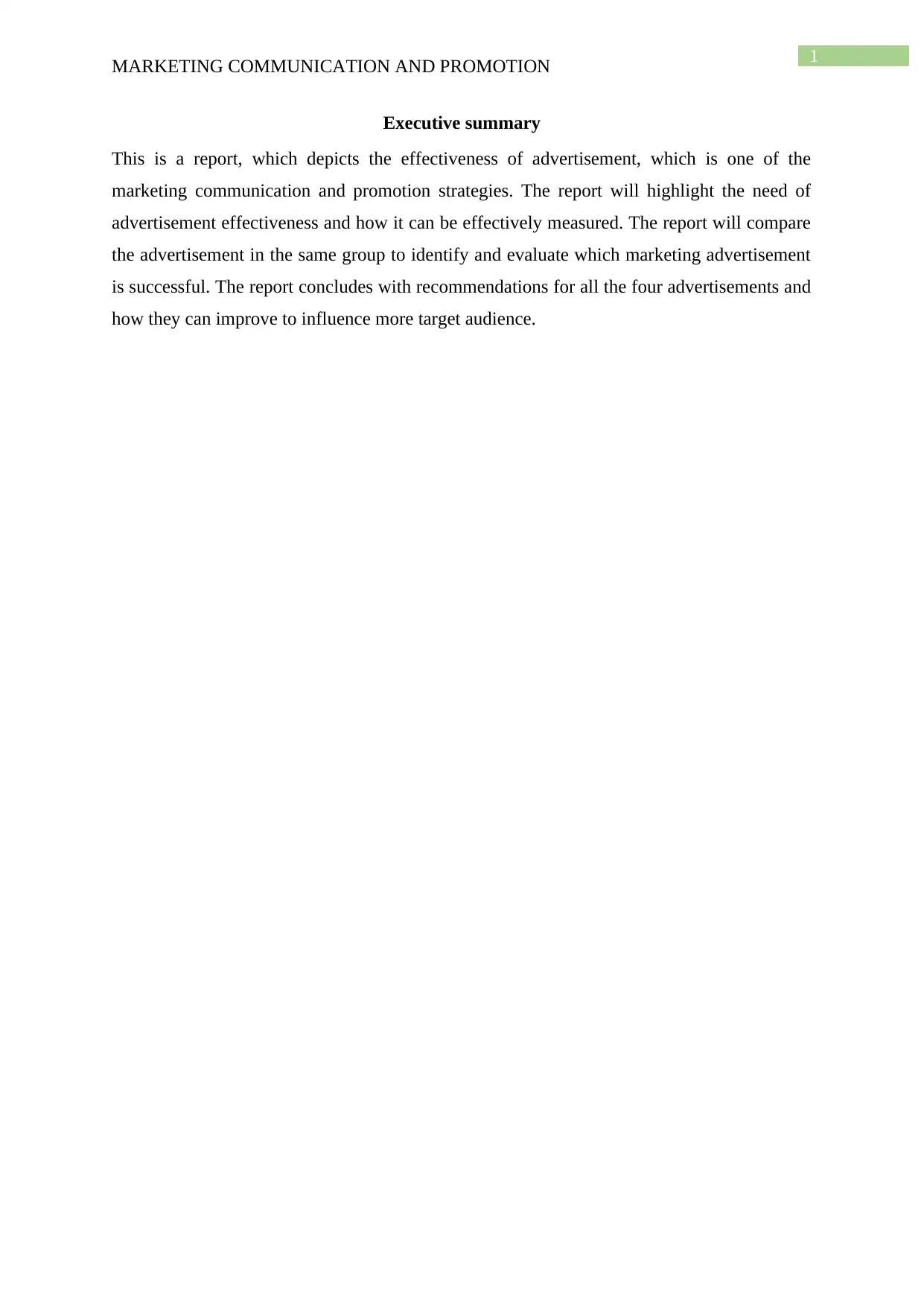
1
MARKETING COMMUNICATION AND PROMOTION
Executive summary
This is a report, which depicts the effectiveness of advertisement, which is one of the
marketing communication and promotion strategies. The report will highlight the need of
advertisement effectiveness and how it can be effectively measured. The report will compare
the advertisement in the same group to identify and evaluate which marketing advertisement
is successful. The report concludes with recommendations for all the four advertisements and
how they can improve to influence more target audience.
MARKETING COMMUNICATION AND PROMOTION
Executive summary
This is a report, which depicts the effectiveness of advertisement, which is one of the
marketing communication and promotion strategies. The report will highlight the need of
advertisement effectiveness and how it can be effectively measured. The report will compare
the advertisement in the same group to identify and evaluate which marketing advertisement
is successful. The report concludes with recommendations for all the four advertisements and
how they can improve to influence more target audience.
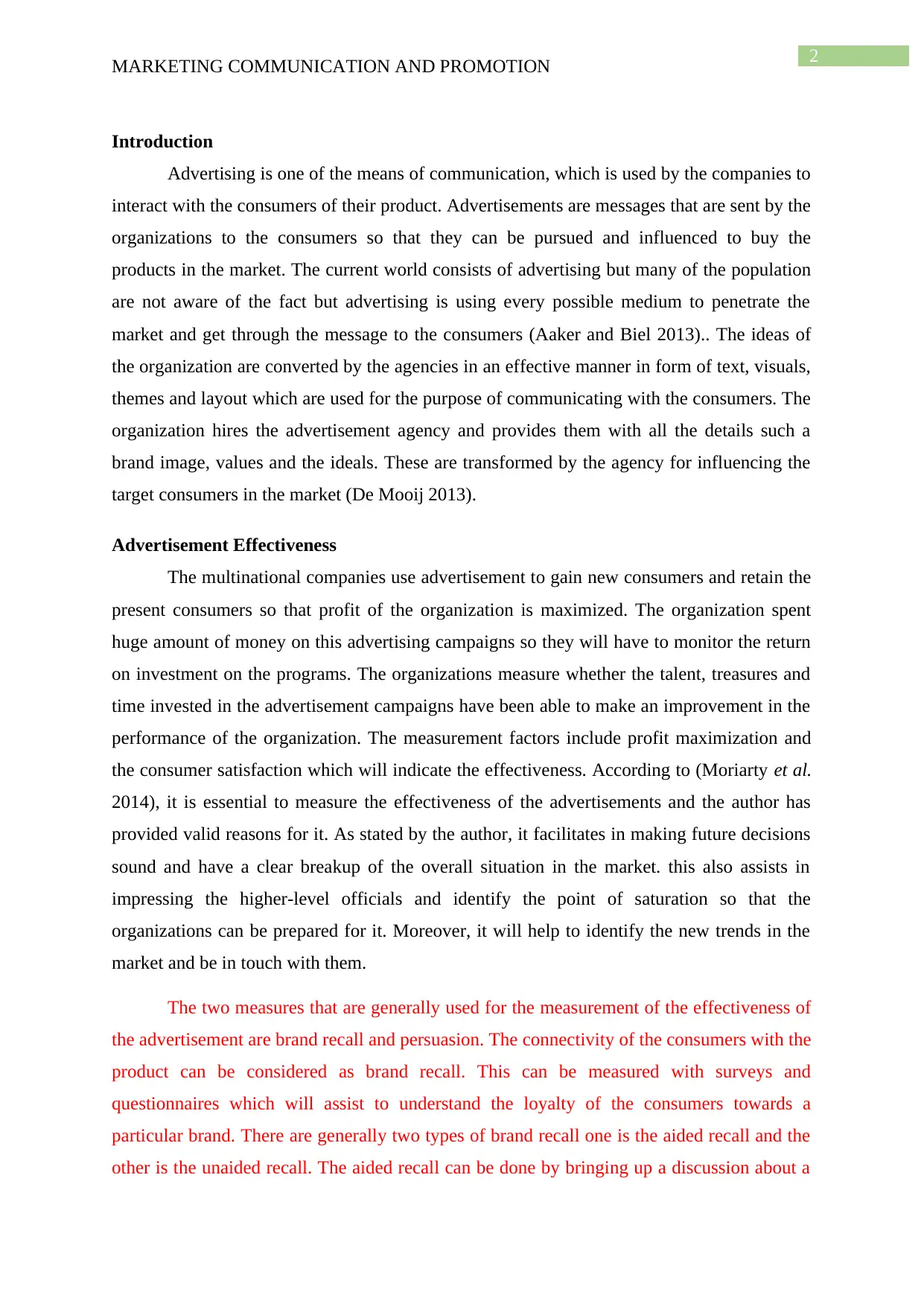
2
MARKETING COMMUNICATION AND PROMOTION
Introduction
Advertising is one of the means of communication, which is used by the companies to
interact with the consumers of their product. Advertisements are messages that are sent by the
organizations to the consumers so that they can be pursued and influenced to buy the
products in the market. The current world consists of advertising but many of the population
are not aware of the fact but advertising is using every possible medium to penetrate the
market and get through the message to the consumers (Aaker and Biel 2013).. The ideas of
the organization are converted by the agencies in an effective manner in form of text, visuals,
themes and layout which are used for the purpose of communicating with the consumers. The
organization hires the advertisement agency and provides them with all the details such a
brand image, values and the ideals. These are transformed by the agency for influencing the
target consumers in the market (De Mooij 2013).
Advertisement Effectiveness
The multinational companies use advertisement to gain new consumers and retain the
present consumers so that profit of the organization is maximized. The organization spent
huge amount of money on this advertising campaigns so they will have to monitor the return
on investment on the programs. The organizations measure whether the talent, treasures and
time invested in the advertisement campaigns have been able to make an improvement in the
performance of the organization. The measurement factors include profit maximization and
the consumer satisfaction which will indicate the effectiveness. According to (Moriarty et al.
2014), it is essential to measure the effectiveness of the advertisements and the author has
provided valid reasons for it. As stated by the author, it facilitates in making future decisions
sound and have a clear breakup of the overall situation in the market. this also assists in
impressing the higher-level officials and identify the point of saturation so that the
organizations can be prepared for it. Moreover, it will help to identify the new trends in the
market and be in touch with them.
The two measures that are generally used for the measurement of the effectiveness of
the advertisement are brand recall and persuasion. The connectivity of the consumers with the
product can be considered as brand recall. This can be measured with surveys and
questionnaires which will assist to understand the loyalty of the consumers towards a
particular brand. There are generally two types of brand recall one is the aided recall and the
other is the unaided recall. The aided recall can be done by bringing up a discussion about a
MARKETING COMMUNICATION AND PROMOTION
Introduction
Advertising is one of the means of communication, which is used by the companies to
interact with the consumers of their product. Advertisements are messages that are sent by the
organizations to the consumers so that they can be pursued and influenced to buy the
products in the market. The current world consists of advertising but many of the population
are not aware of the fact but advertising is using every possible medium to penetrate the
market and get through the message to the consumers (Aaker and Biel 2013).. The ideas of
the organization are converted by the agencies in an effective manner in form of text, visuals,
themes and layout which are used for the purpose of communicating with the consumers. The
organization hires the advertisement agency and provides them with all the details such a
brand image, values and the ideals. These are transformed by the agency for influencing the
target consumers in the market (De Mooij 2013).
Advertisement Effectiveness
The multinational companies use advertisement to gain new consumers and retain the
present consumers so that profit of the organization is maximized. The organization spent
huge amount of money on this advertising campaigns so they will have to monitor the return
on investment on the programs. The organizations measure whether the talent, treasures and
time invested in the advertisement campaigns have been able to make an improvement in the
performance of the organization. The measurement factors include profit maximization and
the consumer satisfaction which will indicate the effectiveness. According to (Moriarty et al.
2014), it is essential to measure the effectiveness of the advertisements and the author has
provided valid reasons for it. As stated by the author, it facilitates in making future decisions
sound and have a clear breakup of the overall situation in the market. this also assists in
impressing the higher-level officials and identify the point of saturation so that the
organizations can be prepared for it. Moreover, it will help to identify the new trends in the
market and be in touch with them.
The two measures that are generally used for the measurement of the effectiveness of
the advertisement are brand recall and persuasion. The connectivity of the consumers with the
product can be considered as brand recall. This can be measured with surveys and
questionnaires which will assist to understand the loyalty of the consumers towards a
particular brand. There are generally two types of brand recall one is the aided recall and the
other is the unaided recall. The aided recall can be done by bringing up a discussion about a
⊘ This is a preview!⊘
Do you want full access?
Subscribe today to unlock all pages.

Trusted by 1+ million students worldwide
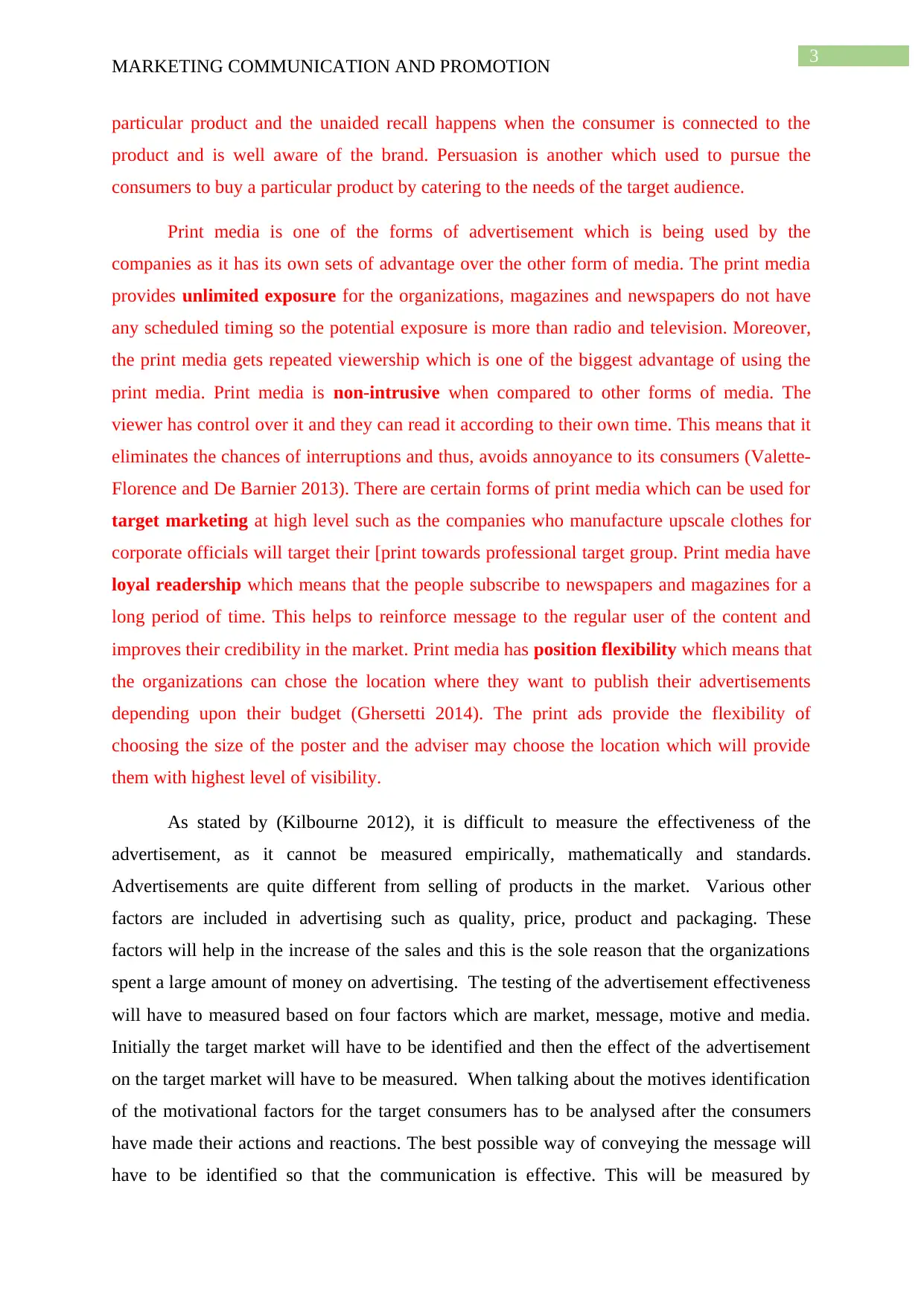
3
MARKETING COMMUNICATION AND PROMOTION
particular product and the unaided recall happens when the consumer is connected to the
product and is well aware of the brand. Persuasion is another which used to pursue the
consumers to buy a particular product by catering to the needs of the target audience.
Print media is one of the forms of advertisement which is being used by the
companies as it has its own sets of advantage over the other form of media. The print media
provides unlimited exposure for the organizations, magazines and newspapers do not have
any scheduled timing so the potential exposure is more than radio and television. Moreover,
the print media gets repeated viewership which is one of the biggest advantage of using the
print media. Print media is non-intrusive when compared to other forms of media. The
viewer has control over it and they can read it according to their own time. This means that it
eliminates the chances of interruptions and thus, avoids annoyance to its consumers (Valette-
Florence and De Barnier 2013). There are certain forms of print media which can be used for
target marketing at high level such as the companies who manufacture upscale clothes for
corporate officials will target their [print towards professional target group. Print media have
loyal readership which means that the people subscribe to newspapers and magazines for a
long period of time. This helps to reinforce message to the regular user of the content and
improves their credibility in the market. Print media has position flexibility which means that
the organizations can chose the location where they want to publish their advertisements
depending upon their budget (Ghersetti 2014). The print ads provide the flexibility of
choosing the size of the poster and the adviser may choose the location which will provide
them with highest level of visibility.
As stated by (Kilbourne 2012), it is difficult to measure the effectiveness of the
advertisement, as it cannot be measured empirically, mathematically and standards.
Advertisements are quite different from selling of products in the market. Various other
factors are included in advertising such as quality, price, product and packaging. These
factors will help in the increase of the sales and this is the sole reason that the organizations
spent a large amount of money on advertising. The testing of the advertisement effectiveness
will have to measured based on four factors which are market, message, motive and media.
Initially the target market will have to be identified and then the effect of the advertisement
on the target market will have to be measured. When talking about the motives identification
of the motivational factors for the target consumers has to be analysed after the consumers
have made their actions and reactions. The best possible way of conveying the message will
have to be identified so that the communication is effective. This will be measured by
MARKETING COMMUNICATION AND PROMOTION
particular product and the unaided recall happens when the consumer is connected to the
product and is well aware of the brand. Persuasion is another which used to pursue the
consumers to buy a particular product by catering to the needs of the target audience.
Print media is one of the forms of advertisement which is being used by the
companies as it has its own sets of advantage over the other form of media. The print media
provides unlimited exposure for the organizations, magazines and newspapers do not have
any scheduled timing so the potential exposure is more than radio and television. Moreover,
the print media gets repeated viewership which is one of the biggest advantage of using the
print media. Print media is non-intrusive when compared to other forms of media. The
viewer has control over it and they can read it according to their own time. This means that it
eliminates the chances of interruptions and thus, avoids annoyance to its consumers (Valette-
Florence and De Barnier 2013). There are certain forms of print media which can be used for
target marketing at high level such as the companies who manufacture upscale clothes for
corporate officials will target their [print towards professional target group. Print media have
loyal readership which means that the people subscribe to newspapers and magazines for a
long period of time. This helps to reinforce message to the regular user of the content and
improves their credibility in the market. Print media has position flexibility which means that
the organizations can chose the location where they want to publish their advertisements
depending upon their budget (Ghersetti 2014). The print ads provide the flexibility of
choosing the size of the poster and the adviser may choose the location which will provide
them with highest level of visibility.
As stated by (Kilbourne 2012), it is difficult to measure the effectiveness of the
advertisement, as it cannot be measured empirically, mathematically and standards.
Advertisements are quite different from selling of products in the market. Various other
factors are included in advertising such as quality, price, product and packaging. These
factors will help in the increase of the sales and this is the sole reason that the organizations
spent a large amount of money on advertising. The testing of the advertisement effectiveness
will have to measured based on four factors which are market, message, motive and media.
Initially the target market will have to be identified and then the effect of the advertisement
on the target market will have to be measured. When talking about the motives identification
of the motivational factors for the target consumers has to be analysed after the consumers
have made their actions and reactions. The best possible way of conveying the message will
have to be identified so that the communication is effective. This will be measured by
Paraphrase This Document
Need a fresh take? Get an instant paraphrase of this document with our AI Paraphraser
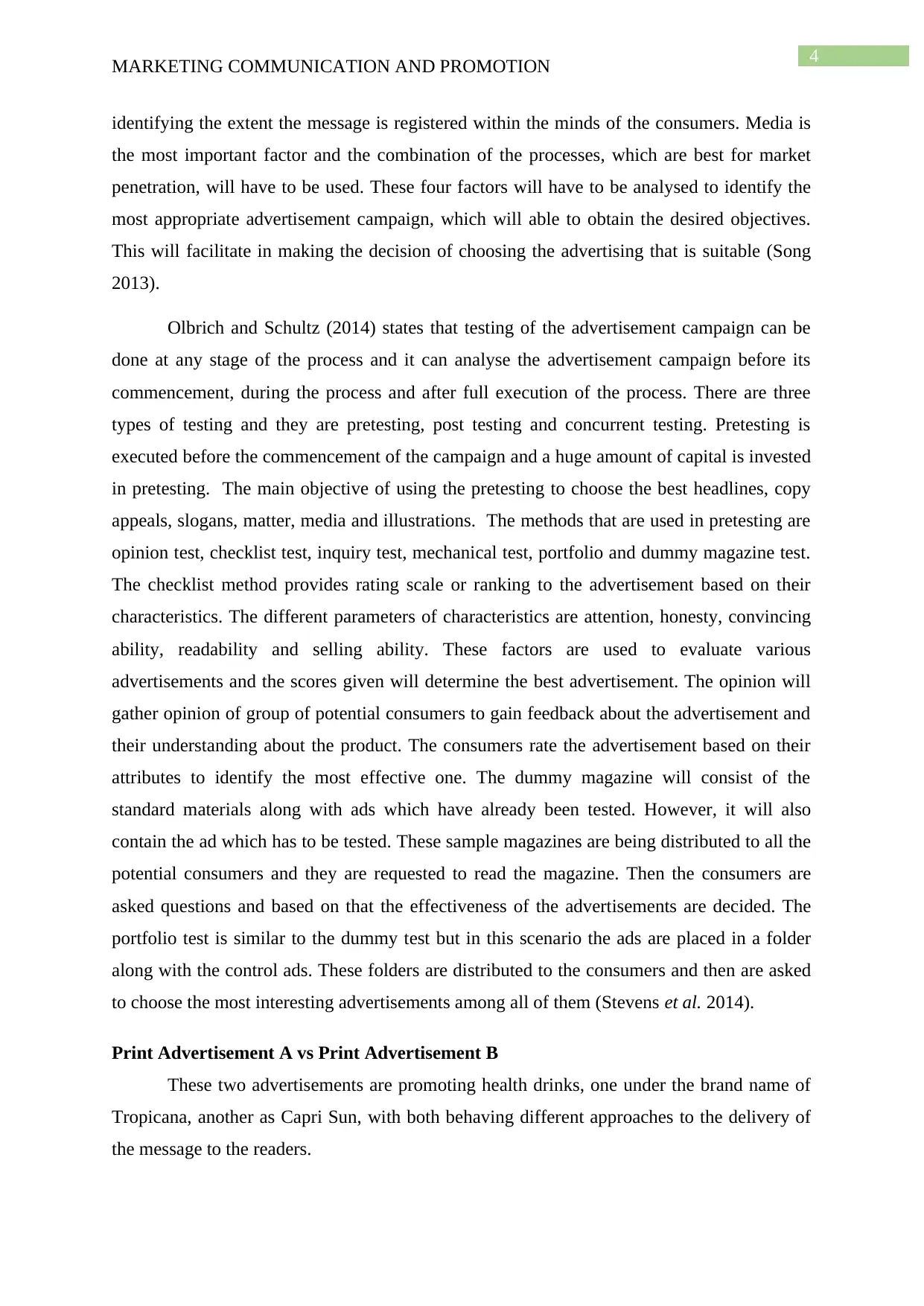
4
MARKETING COMMUNICATION AND PROMOTION
identifying the extent the message is registered within the minds of the consumers. Media is
the most important factor and the combination of the processes, which are best for market
penetration, will have to be used. These four factors will have to be analysed to identify the
most appropriate advertisement campaign, which will able to obtain the desired objectives.
This will facilitate in making the decision of choosing the advertising that is suitable (Song
2013).
Olbrich and Schultz (2014) states that testing of the advertisement campaign can be
done at any stage of the process and it can analyse the advertisement campaign before its
commencement, during the process and after full execution of the process. There are three
types of testing and they are pretesting, post testing and concurrent testing. Pretesting is
executed before the commencement of the campaign and a huge amount of capital is invested
in pretesting. The main objective of using the pretesting to choose the best headlines, copy
appeals, slogans, matter, media and illustrations. The methods that are used in pretesting are
opinion test, checklist test, inquiry test, mechanical test, portfolio and dummy magazine test.
The checklist method provides rating scale or ranking to the advertisement based on their
characteristics. The different parameters of characteristics are attention, honesty, convincing
ability, readability and selling ability. These factors are used to evaluate various
advertisements and the scores given will determine the best advertisement. The opinion will
gather opinion of group of potential consumers to gain feedback about the advertisement and
their understanding about the product. The consumers rate the advertisement based on their
attributes to identify the most effective one. The dummy magazine will consist of the
standard materials along with ads which have already been tested. However, it will also
contain the ad which has to be tested. These sample magazines are being distributed to all the
potential consumers and they are requested to read the magazine. Then the consumers are
asked questions and based on that the effectiveness of the advertisements are decided. The
portfolio test is similar to the dummy test but in this scenario the ads are placed in a folder
along with the control ads. These folders are distributed to the consumers and then are asked
to choose the most interesting advertisements among all of them (Stevens et al. 2014).
Print Advertisement A vs Print Advertisement B
These two advertisements are promoting health drinks, one under the brand name of
Tropicana, another as Capri Sun, with both behaving different approaches to the delivery of
the message to the readers.
MARKETING COMMUNICATION AND PROMOTION
identifying the extent the message is registered within the minds of the consumers. Media is
the most important factor and the combination of the processes, which are best for market
penetration, will have to be used. These four factors will have to be analysed to identify the
most appropriate advertisement campaign, which will able to obtain the desired objectives.
This will facilitate in making the decision of choosing the advertising that is suitable (Song
2013).
Olbrich and Schultz (2014) states that testing of the advertisement campaign can be
done at any stage of the process and it can analyse the advertisement campaign before its
commencement, during the process and after full execution of the process. There are three
types of testing and they are pretesting, post testing and concurrent testing. Pretesting is
executed before the commencement of the campaign and a huge amount of capital is invested
in pretesting. The main objective of using the pretesting to choose the best headlines, copy
appeals, slogans, matter, media and illustrations. The methods that are used in pretesting are
opinion test, checklist test, inquiry test, mechanical test, portfolio and dummy magazine test.
The checklist method provides rating scale or ranking to the advertisement based on their
characteristics. The different parameters of characteristics are attention, honesty, convincing
ability, readability and selling ability. These factors are used to evaluate various
advertisements and the scores given will determine the best advertisement. The opinion will
gather opinion of group of potential consumers to gain feedback about the advertisement and
their understanding about the product. The consumers rate the advertisement based on their
attributes to identify the most effective one. The dummy magazine will consist of the
standard materials along with ads which have already been tested. However, it will also
contain the ad which has to be tested. These sample magazines are being distributed to all the
potential consumers and they are requested to read the magazine. Then the consumers are
asked questions and based on that the effectiveness of the advertisements are decided. The
portfolio test is similar to the dummy test but in this scenario the ads are placed in a folder
along with the control ads. These folders are distributed to the consumers and then are asked
to choose the most interesting advertisements among all of them (Stevens et al. 2014).
Print Advertisement A vs Print Advertisement B
These two advertisements are promoting health drinks, one under the brand name of
Tropicana, another as Capri Sun, with both behaving different approaches to the delivery of
the message to the readers.
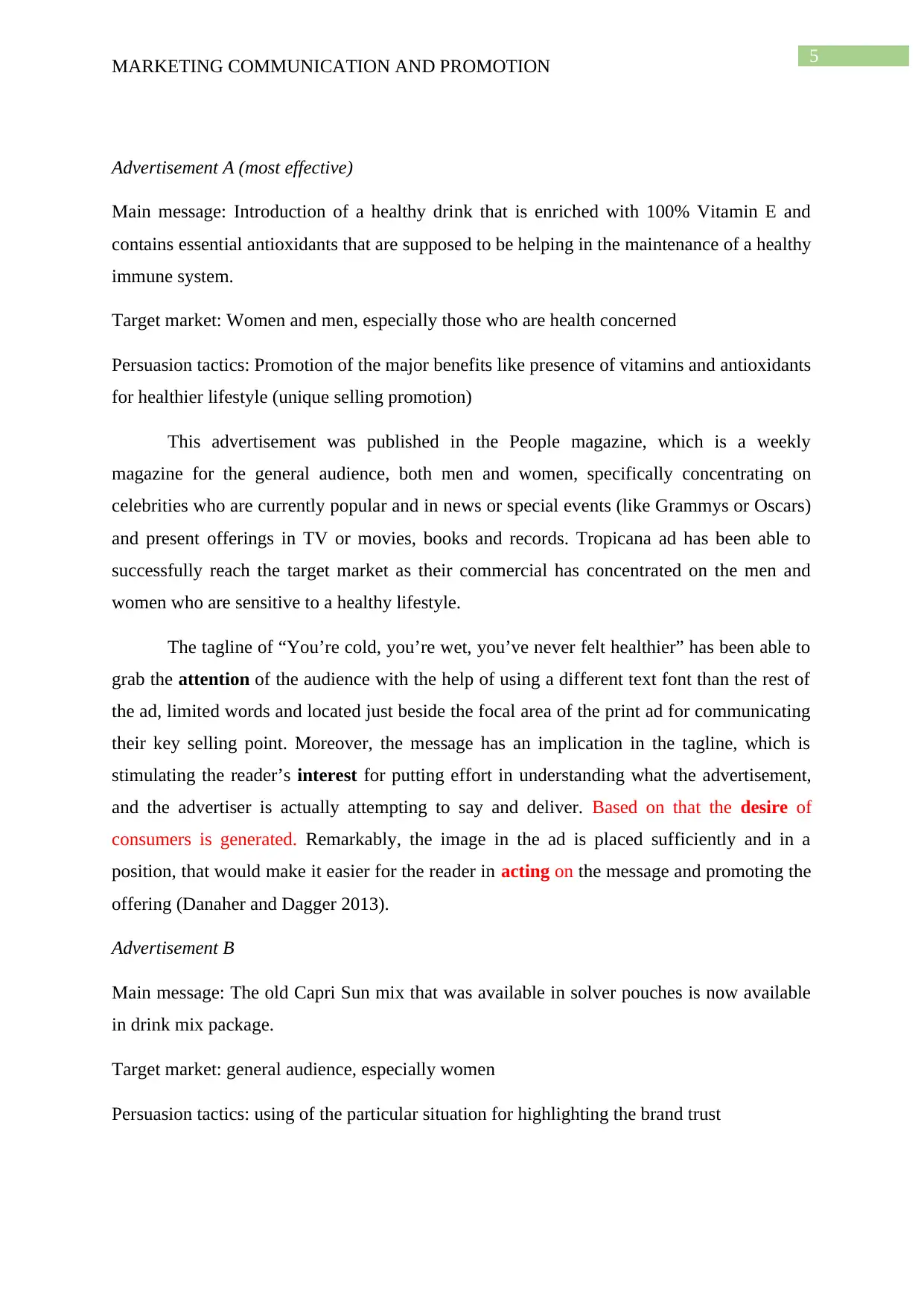
5
MARKETING COMMUNICATION AND PROMOTION
Advertisement A (most effective)
Main message: Introduction of a healthy drink that is enriched with 100% Vitamin E and
contains essential antioxidants that are supposed to be helping in the maintenance of a healthy
immune system.
Target market: Women and men, especially those who are health concerned
Persuasion tactics: Promotion of the major benefits like presence of vitamins and antioxidants
for healthier lifestyle (unique selling promotion)
This advertisement was published in the People magazine, which is a weekly
magazine for the general audience, both men and women, specifically concentrating on
celebrities who are currently popular and in news or special events (like Grammys or Oscars)
and present offerings in TV or movies, books and records. Tropicana ad has been able to
successfully reach the target market as their commercial has concentrated on the men and
women who are sensitive to a healthy lifestyle.
The tagline of “You’re cold, you’re wet, you’ve never felt healthier” has been able to
grab the attention of the audience with the help of using a different text font than the rest of
the ad, limited words and located just beside the focal area of the print ad for communicating
their key selling point. Moreover, the message has an implication in the tagline, which is
stimulating the reader’s interest for putting effort in understanding what the advertisement,
and the advertiser is actually attempting to say and deliver. Based on that the desire of
consumers is generated. Remarkably, the image in the ad is placed sufficiently and in a
position, that would make it easier for the reader in acting on the message and promoting the
offering (Danaher and Dagger 2013).
Advertisement B
Main message: The old Capri Sun mix that was available in solver pouches is now available
in drink mix package.
Target market: general audience, especially women
Persuasion tactics: using of the particular situation for highlighting the brand trust
MARKETING COMMUNICATION AND PROMOTION
Advertisement A (most effective)
Main message: Introduction of a healthy drink that is enriched with 100% Vitamin E and
contains essential antioxidants that are supposed to be helping in the maintenance of a healthy
immune system.
Target market: Women and men, especially those who are health concerned
Persuasion tactics: Promotion of the major benefits like presence of vitamins and antioxidants
for healthier lifestyle (unique selling promotion)
This advertisement was published in the People magazine, which is a weekly
magazine for the general audience, both men and women, specifically concentrating on
celebrities who are currently popular and in news or special events (like Grammys or Oscars)
and present offerings in TV or movies, books and records. Tropicana ad has been able to
successfully reach the target market as their commercial has concentrated on the men and
women who are sensitive to a healthy lifestyle.
The tagline of “You’re cold, you’re wet, you’ve never felt healthier” has been able to
grab the attention of the audience with the help of using a different text font than the rest of
the ad, limited words and located just beside the focal area of the print ad for communicating
their key selling point. Moreover, the message has an implication in the tagline, which is
stimulating the reader’s interest for putting effort in understanding what the advertisement,
and the advertiser is actually attempting to say and deliver. Based on that the desire of
consumers is generated. Remarkably, the image in the ad is placed sufficiently and in a
position, that would make it easier for the reader in acting on the message and promoting the
offering (Danaher and Dagger 2013).
Advertisement B
Main message: The old Capri Sun mix that was available in solver pouches is now available
in drink mix package.
Target market: general audience, especially women
Persuasion tactics: using of the particular situation for highlighting the brand trust
⊘ This is a preview!⊘
Do you want full access?
Subscribe today to unlock all pages.

Trusted by 1+ million students worldwide
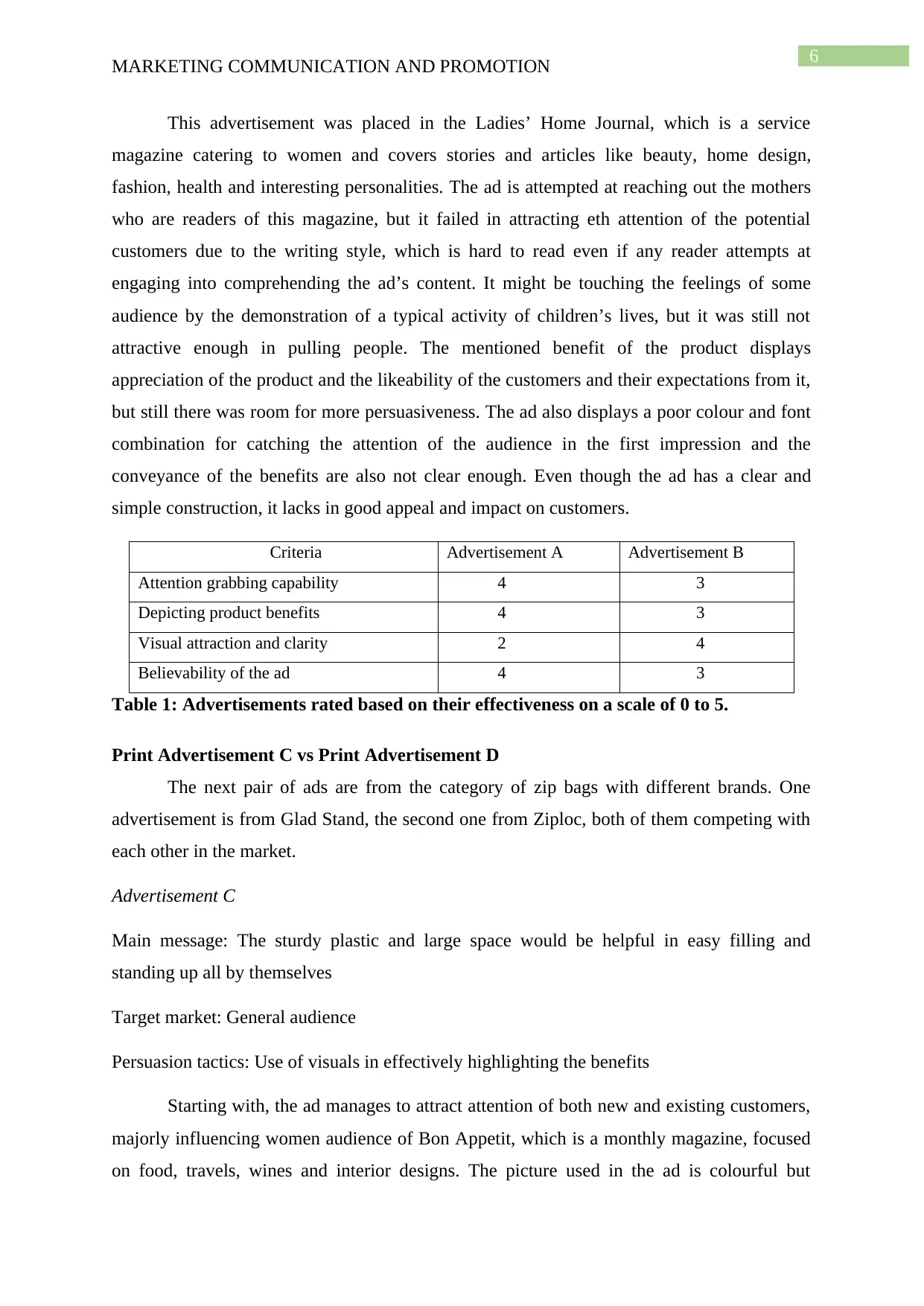
6
MARKETING COMMUNICATION AND PROMOTION
This advertisement was placed in the Ladies’ Home Journal, which is a service
magazine catering to women and covers stories and articles like beauty, home design,
fashion, health and interesting personalities. The ad is attempted at reaching out the mothers
who are readers of this magazine, but it failed in attracting eth attention of the potential
customers due to the writing style, which is hard to read even if any reader attempts at
engaging into comprehending the ad’s content. It might be touching the feelings of some
audience by the demonstration of a typical activity of children’s lives, but it was still not
attractive enough in pulling people. The mentioned benefit of the product displays
appreciation of the product and the likeability of the customers and their expectations from it,
but still there was room for more persuasiveness. The ad also displays a poor colour and font
combination for catching the attention of the audience in the first impression and the
conveyance of the benefits are also not clear enough. Even though the ad has a clear and
simple construction, it lacks in good appeal and impact on customers.
Criteria Advertisement A Advertisement B
Attention grabbing capability 4 3
Depicting product benefits 4 3
Visual attraction and clarity 2 4
Believability of the ad 4 3
Table 1: Advertisements rated based on their effectiveness on a scale of 0 to 5.
Print Advertisement C vs Print Advertisement D
The next pair of ads are from the category of zip bags with different brands. One
advertisement is from Glad Stand, the second one from Ziploc, both of them competing with
each other in the market.
Advertisement C
Main message: The sturdy plastic and large space would be helpful in easy filling and
standing up all by themselves
Target market: General audience
Persuasion tactics: Use of visuals in effectively highlighting the benefits
Starting with, the ad manages to attract attention of both new and existing customers,
majorly influencing women audience of Bon Appetit, which is a monthly magazine, focused
on food, travels, wines and interior designs. The picture used in the ad is colourful but
MARKETING COMMUNICATION AND PROMOTION
This advertisement was placed in the Ladies’ Home Journal, which is a service
magazine catering to women and covers stories and articles like beauty, home design,
fashion, health and interesting personalities. The ad is attempted at reaching out the mothers
who are readers of this magazine, but it failed in attracting eth attention of the potential
customers due to the writing style, which is hard to read even if any reader attempts at
engaging into comprehending the ad’s content. It might be touching the feelings of some
audience by the demonstration of a typical activity of children’s lives, but it was still not
attractive enough in pulling people. The mentioned benefit of the product displays
appreciation of the product and the likeability of the customers and their expectations from it,
but still there was room for more persuasiveness. The ad also displays a poor colour and font
combination for catching the attention of the audience in the first impression and the
conveyance of the benefits are also not clear enough. Even though the ad has a clear and
simple construction, it lacks in good appeal and impact on customers.
Criteria Advertisement A Advertisement B
Attention grabbing capability 4 3
Depicting product benefits 4 3
Visual attraction and clarity 2 4
Believability of the ad 4 3
Table 1: Advertisements rated based on their effectiveness on a scale of 0 to 5.
Print Advertisement C vs Print Advertisement D
The next pair of ads are from the category of zip bags with different brands. One
advertisement is from Glad Stand, the second one from Ziploc, both of them competing with
each other in the market.
Advertisement C
Main message: The sturdy plastic and large space would be helpful in easy filling and
standing up all by themselves
Target market: General audience
Persuasion tactics: Use of visuals in effectively highlighting the benefits
Starting with, the ad manages to attract attention of both new and existing customers,
majorly influencing women audience of Bon Appetit, which is a monthly magazine, focused
on food, travels, wines and interior designs. The picture used in the ad is colourful but
Paraphrase This Document
Need a fresh take? Get an instant paraphrase of this document with our AI Paraphraser
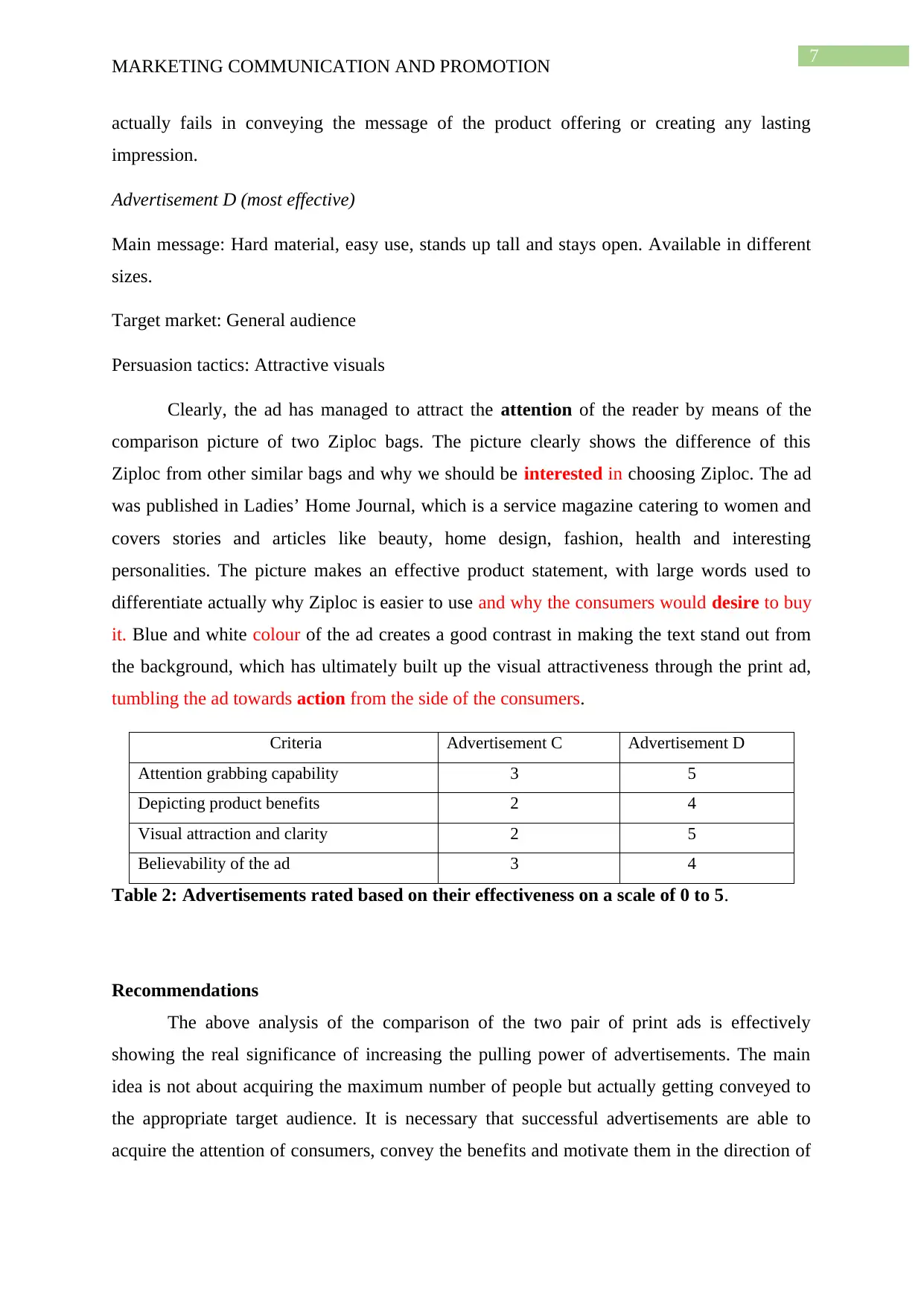
7
MARKETING COMMUNICATION AND PROMOTION
actually fails in conveying the message of the product offering or creating any lasting
impression.
Advertisement D (most effective)
Main message: Hard material, easy use, stands up tall and stays open. Available in different
sizes.
Target market: General audience
Persuasion tactics: Attractive visuals
Clearly, the ad has managed to attract the attention of the reader by means of the
comparison picture of two Ziploc bags. The picture clearly shows the difference of this
Ziploc from other similar bags and why we should be interested in choosing Ziploc. The ad
was published in Ladies’ Home Journal, which is a service magazine catering to women and
covers stories and articles like beauty, home design, fashion, health and interesting
personalities. The picture makes an effective product statement, with large words used to
differentiate actually why Ziploc is easier to use and why the consumers would desire to buy
it. Blue and white colour of the ad creates a good contrast in making the text stand out from
the background, which has ultimately built up the visual attractiveness through the print ad,
tumbling the ad towards action from the side of the consumers.
Criteria Advertisement C Advertisement D
Attention grabbing capability 3 5
Depicting product benefits 2 4
Visual attraction and clarity 2 5
Believability of the ad 3 4
Table 2: Advertisements rated based on their effectiveness on a scale of 0 to 5.
Recommendations
The above analysis of the comparison of the two pair of print ads is effectively
showing the real significance of increasing the pulling power of advertisements. The main
idea is not about acquiring the maximum number of people but actually getting conveyed to
the appropriate target audience. It is necessary that successful advertisements are able to
acquire the attention of consumers, convey the benefits and motivate them in the direction of
MARKETING COMMUNICATION AND PROMOTION
actually fails in conveying the message of the product offering or creating any lasting
impression.
Advertisement D (most effective)
Main message: Hard material, easy use, stands up tall and stays open. Available in different
sizes.
Target market: General audience
Persuasion tactics: Attractive visuals
Clearly, the ad has managed to attract the attention of the reader by means of the
comparison picture of two Ziploc bags. The picture clearly shows the difference of this
Ziploc from other similar bags and why we should be interested in choosing Ziploc. The ad
was published in Ladies’ Home Journal, which is a service magazine catering to women and
covers stories and articles like beauty, home design, fashion, health and interesting
personalities. The picture makes an effective product statement, with large words used to
differentiate actually why Ziploc is easier to use and why the consumers would desire to buy
it. Blue and white colour of the ad creates a good contrast in making the text stand out from
the background, which has ultimately built up the visual attractiveness through the print ad,
tumbling the ad towards action from the side of the consumers.
Criteria Advertisement C Advertisement D
Attention grabbing capability 3 5
Depicting product benefits 2 4
Visual attraction and clarity 2 5
Believability of the ad 3 4
Table 2: Advertisements rated based on their effectiveness on a scale of 0 to 5.
Recommendations
The above analysis of the comparison of the two pair of print ads is effectively
showing the real significance of increasing the pulling power of advertisements. The main
idea is not about acquiring the maximum number of people but actually getting conveyed to
the appropriate target audience. It is necessary that successful advertisements are able to
acquire the attention of consumers, convey the benefits and motivate them in the direction of
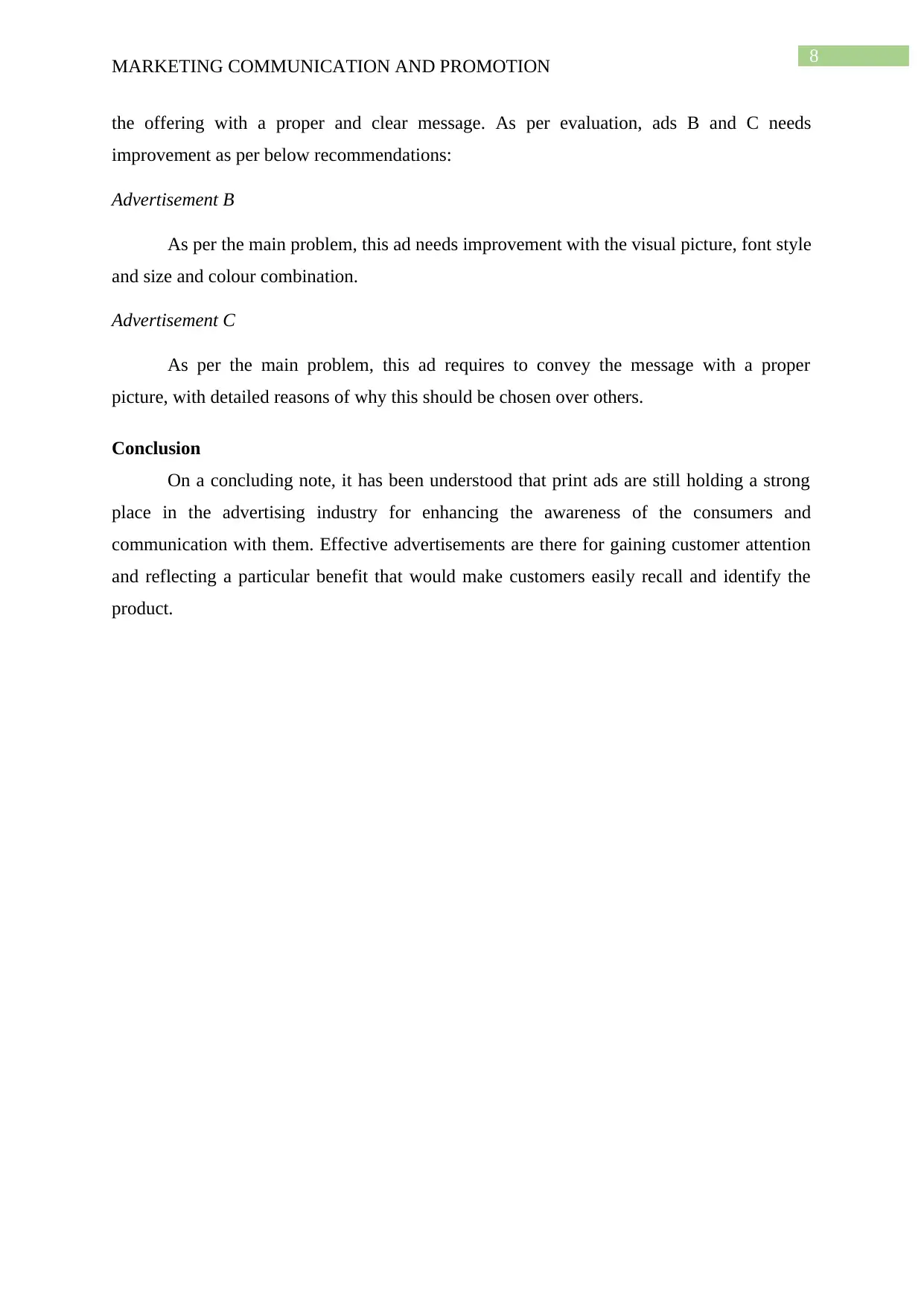
8
MARKETING COMMUNICATION AND PROMOTION
the offering with a proper and clear message. As per evaluation, ads B and C needs
improvement as per below recommendations:
Advertisement B
As per the main problem, this ad needs improvement with the visual picture, font style
and size and colour combination.
Advertisement C
As per the main problem, this ad requires to convey the message with a proper
picture, with detailed reasons of why this should be chosen over others.
Conclusion
On a concluding note, it has been understood that print ads are still holding a strong
place in the advertising industry for enhancing the awareness of the consumers and
communication with them. Effective advertisements are there for gaining customer attention
and reflecting a particular benefit that would make customers easily recall and identify the
product.
MARKETING COMMUNICATION AND PROMOTION
the offering with a proper and clear message. As per evaluation, ads B and C needs
improvement as per below recommendations:
Advertisement B
As per the main problem, this ad needs improvement with the visual picture, font style
and size and colour combination.
Advertisement C
As per the main problem, this ad requires to convey the message with a proper
picture, with detailed reasons of why this should be chosen over others.
Conclusion
On a concluding note, it has been understood that print ads are still holding a strong
place in the advertising industry for enhancing the awareness of the consumers and
communication with them. Effective advertisements are there for gaining customer attention
and reflecting a particular benefit that would make customers easily recall and identify the
product.
⊘ This is a preview!⊘
Do you want full access?
Subscribe today to unlock all pages.

Trusted by 1+ million students worldwide
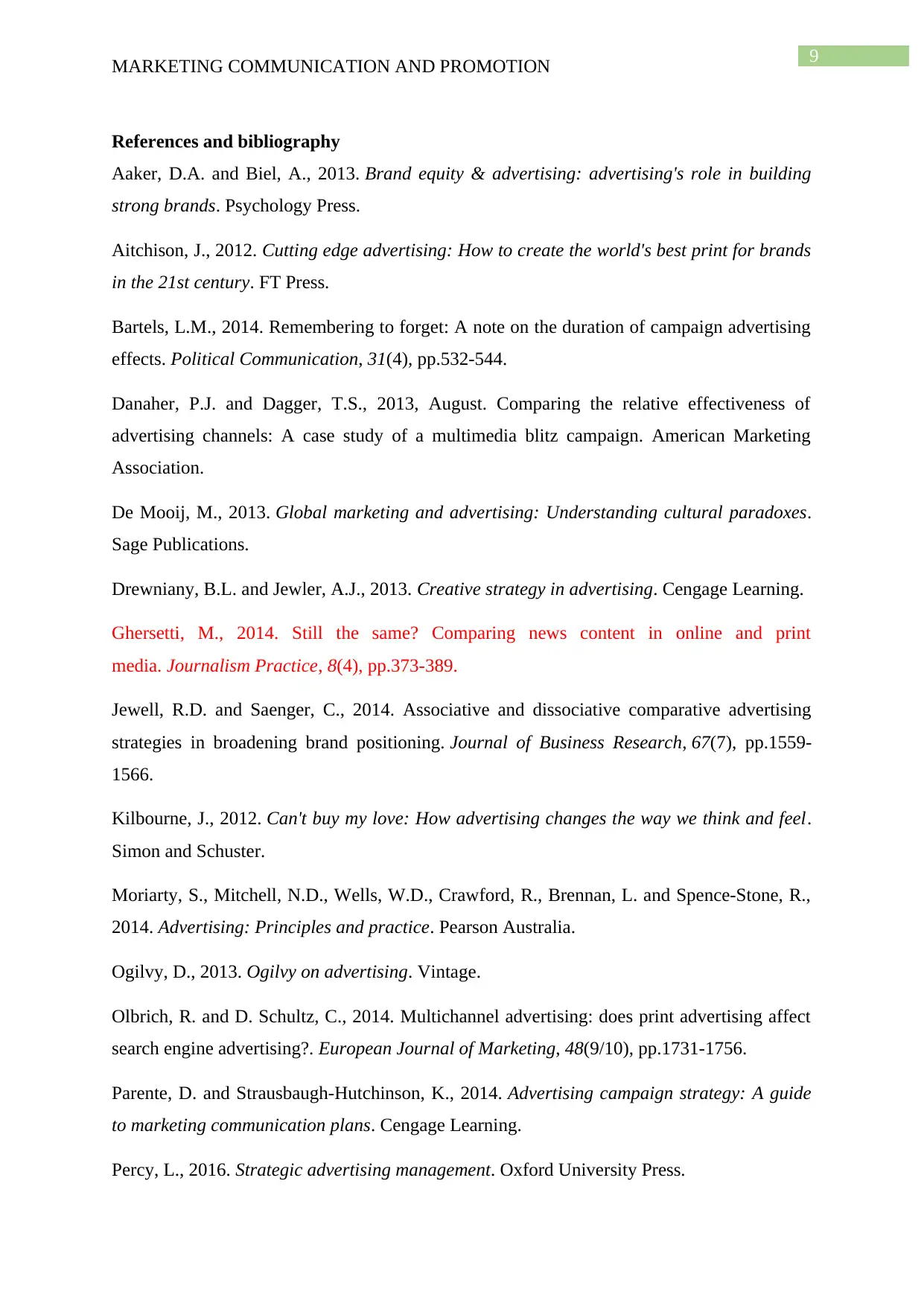
9
MARKETING COMMUNICATION AND PROMOTION
References and bibliography
Aaker, D.A. and Biel, A., 2013. Brand equity & advertising: advertising's role in building
strong brands. Psychology Press.
Aitchison, J., 2012. Cutting edge advertising: How to create the world's best print for brands
in the 21st century. FT Press.
Bartels, L.M., 2014. Remembering to forget: A note on the duration of campaign advertising
effects. Political Communication, 31(4), pp.532-544.
Danaher, P.J. and Dagger, T.S., 2013, August. Comparing the relative effectiveness of
advertising channels: A case study of a multimedia blitz campaign. American Marketing
Association.
De Mooij, M., 2013. Global marketing and advertising: Understanding cultural paradoxes.
Sage Publications.
Drewniany, B.L. and Jewler, A.J., 2013. Creative strategy in advertising. Cengage Learning.
Ghersetti, M., 2014. Still the same? Comparing news content in online and print
media. Journalism Practice, 8(4), pp.373-389.
Jewell, R.D. and Saenger, C., 2014. Associative and dissociative comparative advertising
strategies in broadening brand positioning. Journal of Business Research, 67(7), pp.1559-
1566.
Kilbourne, J., 2012. Can't buy my love: How advertising changes the way we think and feel.
Simon and Schuster.
Moriarty, S., Mitchell, N.D., Wells, W.D., Crawford, R., Brennan, L. and Spence-Stone, R.,
2014. Advertising: Principles and practice. Pearson Australia.
Ogilvy, D., 2013. Ogilvy on advertising. Vintage.
Olbrich, R. and D. Schultz, C., 2014. Multichannel advertising: does print advertising affect
search engine advertising?. European Journal of Marketing, 48(9/10), pp.1731-1756.
Parente, D. and Strausbaugh-Hutchinson, K., 2014. Advertising campaign strategy: A guide
to marketing communication plans. Cengage Learning.
Percy, L., 2016. Strategic advertising management. Oxford University Press.
MARKETING COMMUNICATION AND PROMOTION
References and bibliography
Aaker, D.A. and Biel, A., 2013. Brand equity & advertising: advertising's role in building
strong brands. Psychology Press.
Aitchison, J., 2012. Cutting edge advertising: How to create the world's best print for brands
in the 21st century. FT Press.
Bartels, L.M., 2014. Remembering to forget: A note on the duration of campaign advertising
effects. Political Communication, 31(4), pp.532-544.
Danaher, P.J. and Dagger, T.S., 2013, August. Comparing the relative effectiveness of
advertising channels: A case study of a multimedia blitz campaign. American Marketing
Association.
De Mooij, M., 2013. Global marketing and advertising: Understanding cultural paradoxes.
Sage Publications.
Drewniany, B.L. and Jewler, A.J., 2013. Creative strategy in advertising. Cengage Learning.
Ghersetti, M., 2014. Still the same? Comparing news content in online and print
media. Journalism Practice, 8(4), pp.373-389.
Jewell, R.D. and Saenger, C., 2014. Associative and dissociative comparative advertising
strategies in broadening brand positioning. Journal of Business Research, 67(7), pp.1559-
1566.
Kilbourne, J., 2012. Can't buy my love: How advertising changes the way we think and feel.
Simon and Schuster.
Moriarty, S., Mitchell, N.D., Wells, W.D., Crawford, R., Brennan, L. and Spence-Stone, R.,
2014. Advertising: Principles and practice. Pearson Australia.
Ogilvy, D., 2013. Ogilvy on advertising. Vintage.
Olbrich, R. and D. Schultz, C., 2014. Multichannel advertising: does print advertising affect
search engine advertising?. European Journal of Marketing, 48(9/10), pp.1731-1756.
Parente, D. and Strausbaugh-Hutchinson, K., 2014. Advertising campaign strategy: A guide
to marketing communication plans. Cengage Learning.
Percy, L., 2016. Strategic advertising management. Oxford University Press.
Paraphrase This Document
Need a fresh take? Get an instant paraphrase of this document with our AI Paraphraser
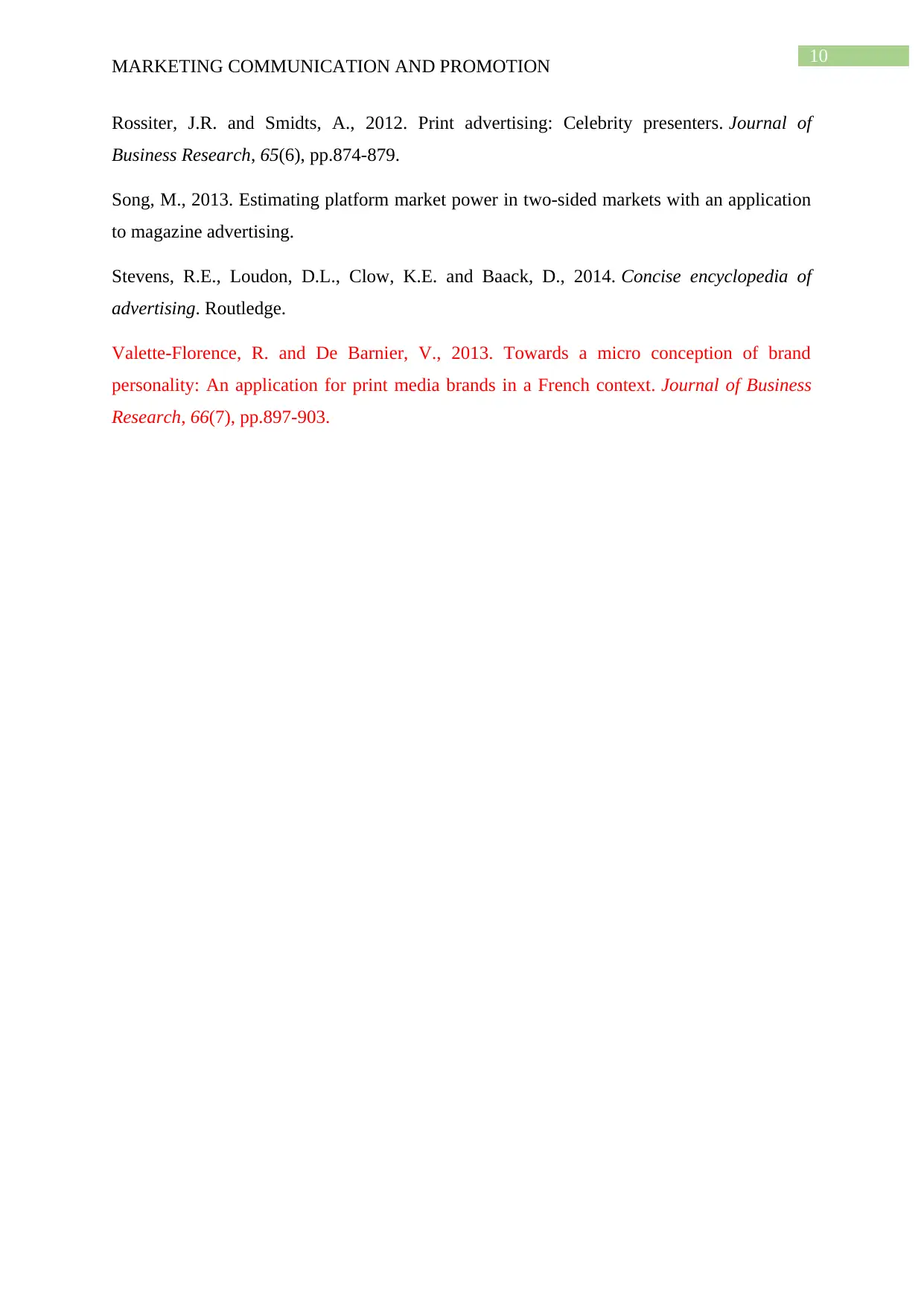
10
MARKETING COMMUNICATION AND PROMOTION
Rossiter, J.R. and Smidts, A., 2012. Print advertising: Celebrity presenters. Journal of
Business Research, 65(6), pp.874-879.
Song, M., 2013. Estimating platform market power in two-sided markets with an application
to magazine advertising.
Stevens, R.E., Loudon, D.L., Clow, K.E. and Baack, D., 2014. Concise encyclopedia of
advertising. Routledge.
Valette-Florence, R. and De Barnier, V., 2013. Towards a micro conception of brand
personality: An application for print media brands in a French context. Journal of Business
Research, 66(7), pp.897-903.
MARKETING COMMUNICATION AND PROMOTION
Rossiter, J.R. and Smidts, A., 2012. Print advertising: Celebrity presenters. Journal of
Business Research, 65(6), pp.874-879.
Song, M., 2013. Estimating platform market power in two-sided markets with an application
to magazine advertising.
Stevens, R.E., Loudon, D.L., Clow, K.E. and Baack, D., 2014. Concise encyclopedia of
advertising. Routledge.
Valette-Florence, R. and De Barnier, V., 2013. Towards a micro conception of brand
personality: An application for print media brands in a French context. Journal of Business
Research, 66(7), pp.897-903.
1 out of 11
Related Documents
Your All-in-One AI-Powered Toolkit for Academic Success.
+13062052269
info@desklib.com
Available 24*7 on WhatsApp / Email
![[object Object]](/_next/static/media/star-bottom.7253800d.svg)
Unlock your academic potential
Copyright © 2020–2025 A2Z Services. All Rights Reserved. Developed and managed by ZUCOL.





